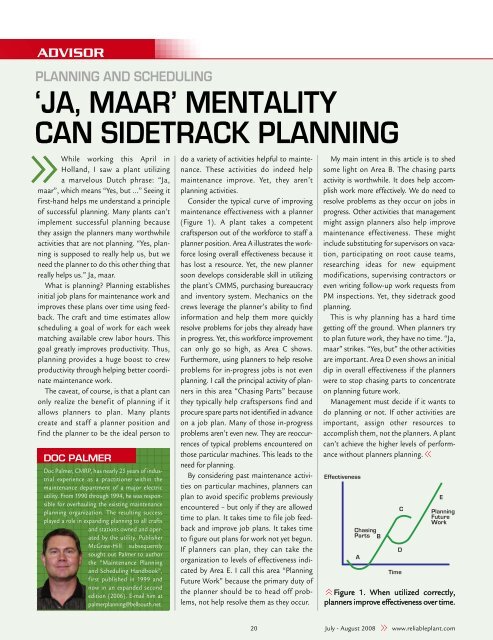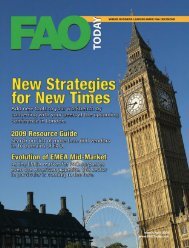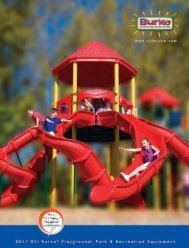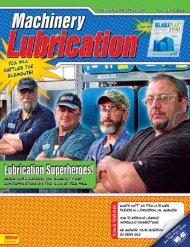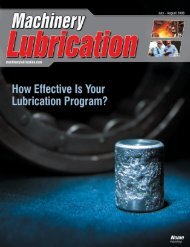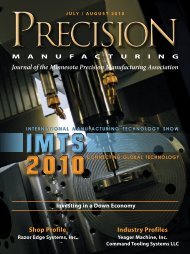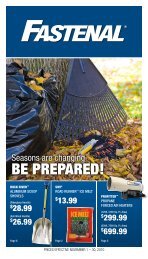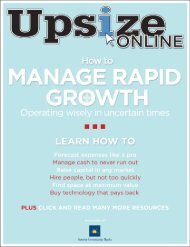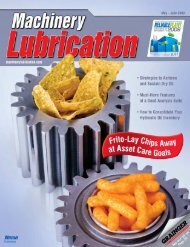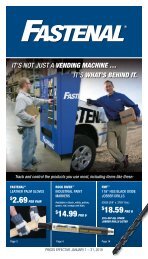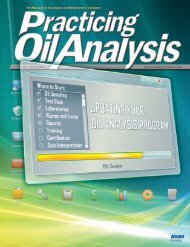Reliable Plant July August 2008
Reliable Plant July August 2008
Reliable Plant July August 2008
You also want an ePaper? Increase the reach of your titles
YUMPU automatically turns print PDFs into web optimized ePapers that Google loves.
ADVISOR<br />
PLANNING AND SCHEDULING<br />
‘JA, MAAR’ MENTALITY<br />
CAN SIDETRACK PLANNING<br />
While working this April in<br />
Holland, I saw a plant utilizing<br />
a marvelous Dutch phrase: “Ja,<br />
maar”, which means “Yes, but ...” Seeing it<br />
first-hand helps me understand a principle<br />
of successful planning. Many plants can’t<br />
implement successful planning because<br />
they assign the planners many worthwhile<br />
activities that are not planning. “Yes, planning<br />
is supposed to really help us, but we<br />
need the planner to do this other thing that<br />
really helps us.” Ja, maar.<br />
What is planning? Planning establishes<br />
initial job plans for maintenance work and<br />
improves these plans over time using feedback.<br />
The craft and time estimates allow<br />
scheduling a goal of work for each week<br />
matching available crew labor hours. This<br />
goal greatly improves productivity. Thus,<br />
planning provides a huge boost to crew<br />
productivity through helping better coordinate<br />
maintenance work.<br />
The caveat, of course, is that a plant can<br />
only realize the benefit of planning if it<br />
allows planners to plan. Many plants<br />
create and staff a planner position and<br />
find the planner to be the ideal person to<br />
DOC PALMER<br />
Doc Palmer, CMRP, has nearly 25 years of industrial<br />
experience as a practitioner within the<br />
maintenance department of a major electric<br />
utility. From 1990 through 1994, he was responsible<br />
for overhauling the existing maintenance<br />
planning organization. The resulting success<br />
played a role in expanding planning to all crafts<br />
and stations owned and operated<br />
by the utility. Publisher<br />
McGraw-Hill subsequently<br />
sought out Palmer to author<br />
the “Maintenance Planning<br />
and Scheduling Handbook”,<br />
first published in 1999 and<br />
now in an expanded second<br />
edition (2006). E-mail him at<br />
palmerplanning@bellsouth.net.<br />
do a variety of activities helpful to maintenance.<br />
These activities do indeed help<br />
maintenance improve. Yet, they aren’t<br />
planning activities.<br />
Consider the typical curve of improving<br />
maintenance effectiveness with a planner<br />
(Figure 1). A plant takes a competent<br />
craftsperson out of the workforce to staff a<br />
planner position. Area A illustrates the workforce<br />
losing overall effectiveness because it<br />
has lost a resource. Yet, the new planner<br />
soon develops considerable skill in utilizing<br />
the plant’s CMMS, purchasing bureaucracy<br />
and inventory system. Mechanics on the<br />
crews leverage the planner’s ability to find<br />
information and help them more quickly<br />
resolve problems for jobs they already have<br />
in progress. Yet, this workforce improvement<br />
can only go so high, as Area C shows.<br />
Furthermore, using planners to help resolve<br />
problems for in-progress jobs is not even<br />
planning. I call the principal activity of planners<br />
in this area “Chasing Parts” because<br />
they typically help craftspersons find and<br />
procure spare parts not identified in advance<br />
on a job plan. Many of those in-progress<br />
problems aren’t even new. They are reoccurrences<br />
of typical problems encountered on<br />
those particular machines. This leads to the<br />
need for planning.<br />
By considering past maintenance activities<br />
on particular machines, planners can<br />
plan to avoid specific problems previously<br />
encountered – but only if they are allowed<br />
time to plan. It takes time to file job feedback<br />
and improve job plans. It takes time<br />
to figure out plans for work not yet begun.<br />
If planners can plan, they can take the<br />
organization to levels of effectiveness indicated<br />
by Area E. I call this area “Planning<br />
Future Work” because the primary duty of<br />
the planner should be to head off problems,<br />
not help resolve them as they occur.<br />
My main intent in this article is to shed<br />
some light on Area B. The chasing parts<br />
activity is worthwhile. It does help accomplish<br />
work more effectively. We do need to<br />
resolve problems as they occur on jobs in<br />
progress. Other activities that management<br />
might assign planners also help improve<br />
maintenance effectiveness. These might<br />
include substituting for supervisors on vacation,<br />
participating on root cause teams,<br />
researching ideas for new equipment<br />
modifications, supervising contractors or<br />
even writing follow-up work requests from<br />
PM inspections. Yet, they sidetrack good<br />
planning.<br />
This is why planning has a hard time<br />
getting off the ground. When planners try<br />
to plan future work, they have no time. “Ja,<br />
maar” strikes. “Yes, but” the other activities<br />
are important. Area D even shows an initial<br />
dip in overall effectiveness if the planners<br />
were to stop chasing parts to concentrate<br />
on planning future work.<br />
Management must decide if it wants to<br />
do planning or not. If other activities are<br />
important, assign other resources to<br />
accomplish them, not the planners. A plant<br />
can’t achieve the higher levels of performance<br />
without planners planning.<br />
Effectiveness<br />
Chasing<br />
Parts B<br />
A<br />
Time<br />
Planning<br />
Future<br />
Work<br />
Figure 1. When utilized correctly,<br />
planners improve effectiveness over time.<br />
C<br />
D<br />
E<br />
20 <strong>July</strong> - <strong>August</strong> <strong>2008</strong> www.reliableplant.com


